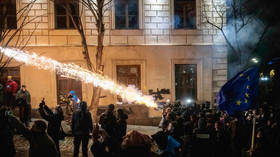[
Georgia’s partially on fire, but this is not 2003 and the US and EU may find things rather more difficult this time
A ‘color revolution’, as we define it, is a mass uprising fueled by the rejection of official election results, backed by political, diplomatic, and financial support from external forces. This idea first took root in Serbia in 2000, with the overthrow of Slobodan Milosevic. The term itself emerged three years later in Georgia, where protesters led by Mikhail Saakashvili adopted roses as their symbol. Another three years later, Ukraine’s 2004 Orange Revolution marked the color shift to orange.
A decade ago, ‘color revolutions’ seemed to have peaked, especially after the bloody Euromaidan in Ukraine, which plunged the country into a prolonged series of armed conflicts. This development made previous uprisings appear relatively tame. The phenomenon appeared to have receded, only to reemerge in Armenia in 2018 – though this was more of an internal shift than an externally influenced one. Meanwhile, Belarus’s failed 2020 revolution, met with stern resistance from authorities and a clear warning from Moscow, looked like a line in the sand.
Yet, the situation in Georgia today – with large pro-Western opposition protests – suggests the possibility of a new mass protest, though it is dramatically different from the past. The ruling Georgian Dream party has locked itself into an intense standoff with the political West, particularly with the US and EU. It is surprising to see Georgia’s government stand so firmly against its Western partners, but there is little choice; as history has shown, the US-led bloc does not tolerate half-measures when its interests are at stake.
Three key calculations driving Georgian Dream’s strategy
Bidzina Ivanishvili, the founder of Georgian Dream, and his party base their strategy on three main conclusions:
Firstly, Western Europe and the US, preoccupied with issues far beyond the South Caucasus, are unlikely to direct the same level of political and material resources to Georgia as they did in previous revolutions. In today’s global environment, Tbilisi is simply not a priority.
Secondly, the context has changed. When the Rose Revolution unfolded in 2003, Georgia was in a dire state. The government, led by Eduard Shevardnadze, was deeply unpopular, and the country was in disarray. Today, Georgia enjoys relative stability and economic growth. While challenges persist, the choice between “real prosperity” and a fleeting, uncertain promise of Western-led change has shifted the balance of opinion in favor of continuity.
Thirdly, a regime change in Georgia now would almost certainly lead to chaos. The experience of countries in the region shows that compromises and yielding to external pressure lead to the collapse of governments. Ivanishvili’s strategy is clear: resist Western influence, as succumbing to it has proven disastrous for others.
The risks and dynamics at play
However, the Tbilisi authorities’ calculations could be flawed. The significance of events in Georgia now extends beyond its borders, especially in light of the escalating tensions over Ukraine and political shifts in the US. The West’s desire to undermine what it perceives as pro-Russian forces has made Georgia a symbolic battleground, amplifying the consequences of any perceived defiance. The fact that Georgian Dream is in no way pro-Russian, but simply seeks to maintain a detached position, does not change the situation.
Tbilisi’s decision to freeze EU accession talks was a bold move, signaling its willingness to challenge Western demands. The EU sees its ability to influence its applicants as a point of pride, and any setback, like Georgia’s hesitation, will be seen as a failure of its policies. Those who are seen as clients of the West must now swear an oath. And unwillingness to follow the common path is equated with treason.
This situation raises questions about the degree of public support for the government’s stance. The Georgian population has long been divided on the issue of European integration. The government’s position resonates with some, particularly those who see the West’s influence as counterproductive, while others demand a clearer path toward EU membership.
What’s next for the country?
For the opposition, this is an opportunity to exploit popular discontent and mobilize protests. The key challenge for both sides will be managing the potential for violence. ‘Color revolutions’ have always relied on the ability to escalate tensions and frame the government as authoritarian. The authorities, for their part, must maintain a delicate balance, avoiding provocations while standing firm against external pressure.
The ‘European future’ is a popular image among Georgians, and the majority of Georgian Dream supporters share this aspiration too. The party itself is firmly committed to the goals of European integration, but with its own conditions. The opposition’s argument is that the government is blocking the European path, which automatically means that Tbilisi will return to Moscow’s sphere of influence. The only question is how persistently and passionately this argument will be repeated.
The future of Georgia’s sovereignty
The ‘color revolution’ model, once a symbol of democratic aspirations, risks being used as a blunt tool in geopolitical maneuvering. Whether these external forces can still effectively destabilize governments in the region remains to be seen.
Democracy promotion (in various guises) was relevant as long as the Western idea of socio-political progress was seen as essentially the only option. Now, as the global order undergoes significant change, this era of unchallenged Western influence is ending, replaced by a fierce struggle for a place in the new geopolitical system. The term ‘color revolution’ has evolved from a symbol of popular democratic uprisings to a tool of political engineering used by the West for influence. The question now is whether these revolutions still have the power to destabilize countries like Georgia – or if the state can resist the pressure and secure its sovereignty in a new world order.
This article was first published by the newspaper Profile and was translated and edited by the RT team




